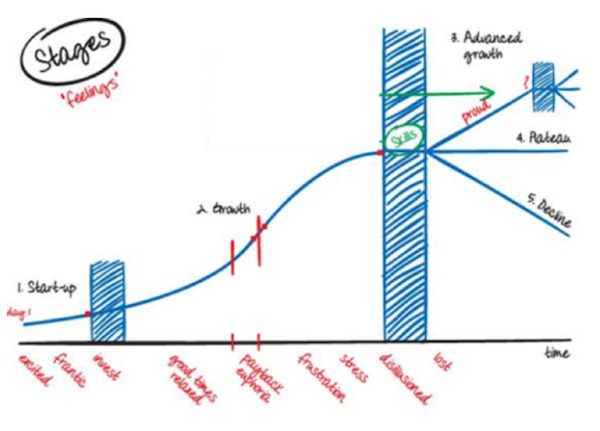Feeling weighed down by your business? Or nostalgic for the irrepressible fun of those heady start-up days? Do you yearn to turn the clock back to a time when life seemed easier somehow? And the money seemed to just roll in? Maybe you’re constantly looking over your shoulder. Your competitors are doing better and you’re wondering why it’s no longer happening for you. You feel like you’re completely alone. But we’re here to tell you, you’re really not.
Many of our new CEO clients feel this way. Why? Because their businesses have hit a wall. Yes, they’re growing – some of them quite fast. But their profitability has fallen off a cliff. It’s very likely that their business is stuck in the ‘growth trap’.
What is the growth trap?
Companies get stuck in this trap when their organisation has become increasingly complex due to their growth. Growth sucks cash. Revenue increases but so do costs, meaning profitability starts to drop. Running the company takes more and more time and energy. CEOs begin to burn out.
Businesses stuck in the growth trap find themselves in a no man’s land where they’re sinking more and more investment into the company with no return. Some are founder-led with a turnover of £1.5 million and 12 to 15 staff. Others are bigger with a management team and turnover approaching £100 million. Others still are formed through M&A and need to start all over again with new processes and systems. What unites them all is they need to get out of the trap before they can re-gain forward momentum.
Is your business stuck?

You can tell a lot from how you feel. Above is a great model produced by Shirlaws that perfectly sums up the stages of company growth. We like it because it focuses on the feelings of CEOs and their management team as they move up the curve. When they start out, there’s excitement and positivity. The realisation hits that the plan’s going to work so they start to invest. Good times arrive with a sense of payback for all the hard work. There’s a sense of euphoria. Maybe they take a long holiday or buy a new car.
Growth continues but the business gets more complicated. There are more staff and more customers. Satisfaction levels start to fall away and frustration creeps in. Profitability drops until eventually, the company hits a wall. There are only three directions after this. The first is to restructure and continue growing. The second is to plateau, beginning a long, slow decline. And the third brutal trajectory is a steep downhill towards the eventual folding of the business.
It’s not uncommon for CEOs to be highly emotional when we first speak to them. Often, they regret their growth and there’s a big sense of disillusionment. It’s why they come looking for a coach in the first place. They don’t feel they have the skills and tools to escape the trap they’re in. Their business has transformed from a boutique to a scaling business and they’re stuck in no man’s land, where they’re investing but seeing no return.
Lack of strategic focus
So how did they get here? To unravel why the growth trap happens, it’s useful to refer to Michael Porter. The founder of modern strategy, he was one of the world’s most influential thinkers on management and competitiveness. Porter said the desire to grow often has a perverse impact on strategy. If you’ve got ambitious growth targets, you’re likely to be chasing revenue. When opportunities pop up, you take them. But if you didn’t start out with a clear strategic view of your positioning in the marketplace, this can cause a whole heap of problems.
Sometimes you battle through. The reason you’ve got your business to £30 million is you’ve focused on operational effectiveness. But, because there’s no focus on positioning, you find you’re the same as all your competitors. There’s convergence on the productivity frontier. No one has a differentiated strategy. Everyone’s the same. You’re just copying each other’s products and systems. You’re even swapping staff which prolongs the nightmare.
It’s so important to have a narrow, deep strategic focus. When I was UK MD of Rackspace, we had a mantra. ‘We’re an inch wide and a mile deep’. Our purpose was ‘Fanatical Support’ and our BHAG was to become ‘the Ritz Carlton of IT Services’. This prevented strategic drift, keeping us narrow. And it helped give us the confidence to say ‘no’ more than we said ‘yes’.
Our strategic positioning gave us certainty on what we did and didn’t do. People would say, ‘Why don’t you chase this revenue opportunity? Or this one?’ But, if it didn’t fit with our purpose or BHAG, we always declined. What a great thing to learn early on in my career.
Finding a strategy that drives competitive advantage

Successful strategy stems from competitive advantage. Find this and you’ll avoid the trap. Take our distribution client, Ontruck. When they first came to us, they were teetering on the brink of the growth trap. There were two freight strands to their business – LTL (Less Than Load) and FTL (Full Truck Load). FTL was growing fast and had become their main focus. Their hypothesis was that customers who gave them their FTL long haul business would form a relationship with them. And that would lead to them giving Ontruck their short-haul contracts too. But it didn’t happen. When we dug deeper, we realised FTL had no strategic advantage. It was growing but it wasn’t driving profitability.
So, we asked them, ‘Where do you have an advantage that your competitors can’t copy?’ After some hefty spade-work, we struck gold. In their LTL business, they had bespoke software algorithms that allowed them to schedule rapid pickups – both instant and 24 hour. They switched their strategy to focus on this part of their business. Now, they’re even using metrics that are different to the rest of their industry – their profit per x is a differentiator. Ontruck found themselves in the growth trap, did the work and are now out the other side.
Identifying leading indicators
Do you have leading indicators that help you track profitability? They can act as an early warning system that you’re heading into the growth trap. At Rackspace, I had two drivers – revenue growth and EBITDA (earnings before interest, taxes, depreciation and amortisation). To get my bonus, I had to stay on track with both. As we grew, I could see the costs increasing. What we needed was a forward forecast. This was my first introduction to leading indicators and I’ve used them ever since.
The biggest impact for us on EBITDA was hiring staff. So, we looked at the revenue forecast and took a view on how solid it was for the next quarter. And then we managed the EBITDA outcome from that quarter based on how many heads we would hire over the next 90 days. So at the beginning of each quarter, we would say, ‘Given the forecast, how many heads could we bring on board and still hit our EBITDA number? And which of these hires are the most pressing?’
We always felt we could do with more staff. Growth was coming thick and fast and it felt like we weren’t doing enough to build the solid foundations. But it’s like changing your running style to go faster. You lean forward to the point where you feel like you’re going to fall over, and then you run at a higher cadence. There’s a process of allowing yourself to do that. You need to get comfortable with being on the edge. And your speed increases accordingly.
Reducing complexity
Returning to Michael Porter’s views on the growth trap. He observed how companies grow by extending their product lines and features. This happens all the time. Often, it leads to over-promising and under-delivering.
Let me ask you this. ‘If I make you a promise and I keep it, do I generate a positive feeling from you?’ Your automatic answer might be yes, but actually, the reverse is true. When you tell someone you’re going to do something, you’re creating an expectation. So when you do it, it’s less of a surprise. It’s like telling someone that you’ve bought them an amazing present for their birthday before you actually give it to them. It spoils the impact.
So often, companies will promise things that the customer hasn’t asked for. Nine times out of ten, these things don’t add any value, like sending a monthly report that the customer never reads. Even worse, if you promise a monthly report and then don’t deliver it, you’ve added insult to injury. The customer really hates you now! Activities like this add cost and complexity to a business unnecessarily. And sometimes, they set you up for failure.
Focusing on activities that fit together
Part of a strategy is looking at how all your activities fit together. And taking a core activity down a series of levels. If all the activities interconnect, you have a system that’s really hard to copy. Even better, if your competitors only copy parts of it, they get no value or even negative value.
If your strategy is too broad, it’s common to find activity fit systems that don’t support each other. Instead, you have complexity. In a small business (say around £30 – £50 million turnover) these won’t be self-sustaining, profitable parts of the business. They’re often unwieldy and will lose you money. And hidden amongst the complexity, there are activities that are more profitable.
Here’s a great example. A new client came to one of our recent workshops. It had never occurred to them to look at customer profitability. When they did this, they realised they had a whole slew of customers to whom they’re delivering a service unprofitably. This may have been because people had forgotten to put their prices up over the years.
When you’re reviewing your activities, look for the things that are high value for your customer and low cost for you. These should be bundled and delivered in a way that your competitors would find it impossible to price as a standalone service. That’s the magic of the activity fit system working right there. It results in a package of services that your customers value and your competitors can’t pick to pieces.

